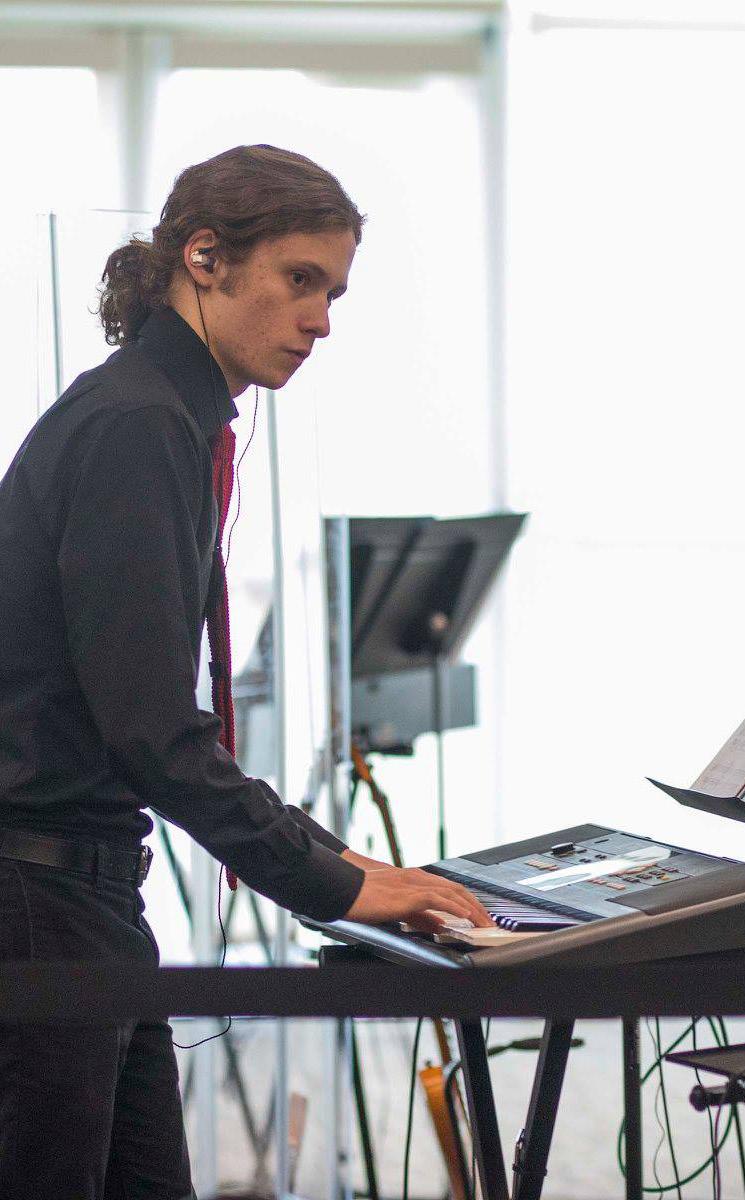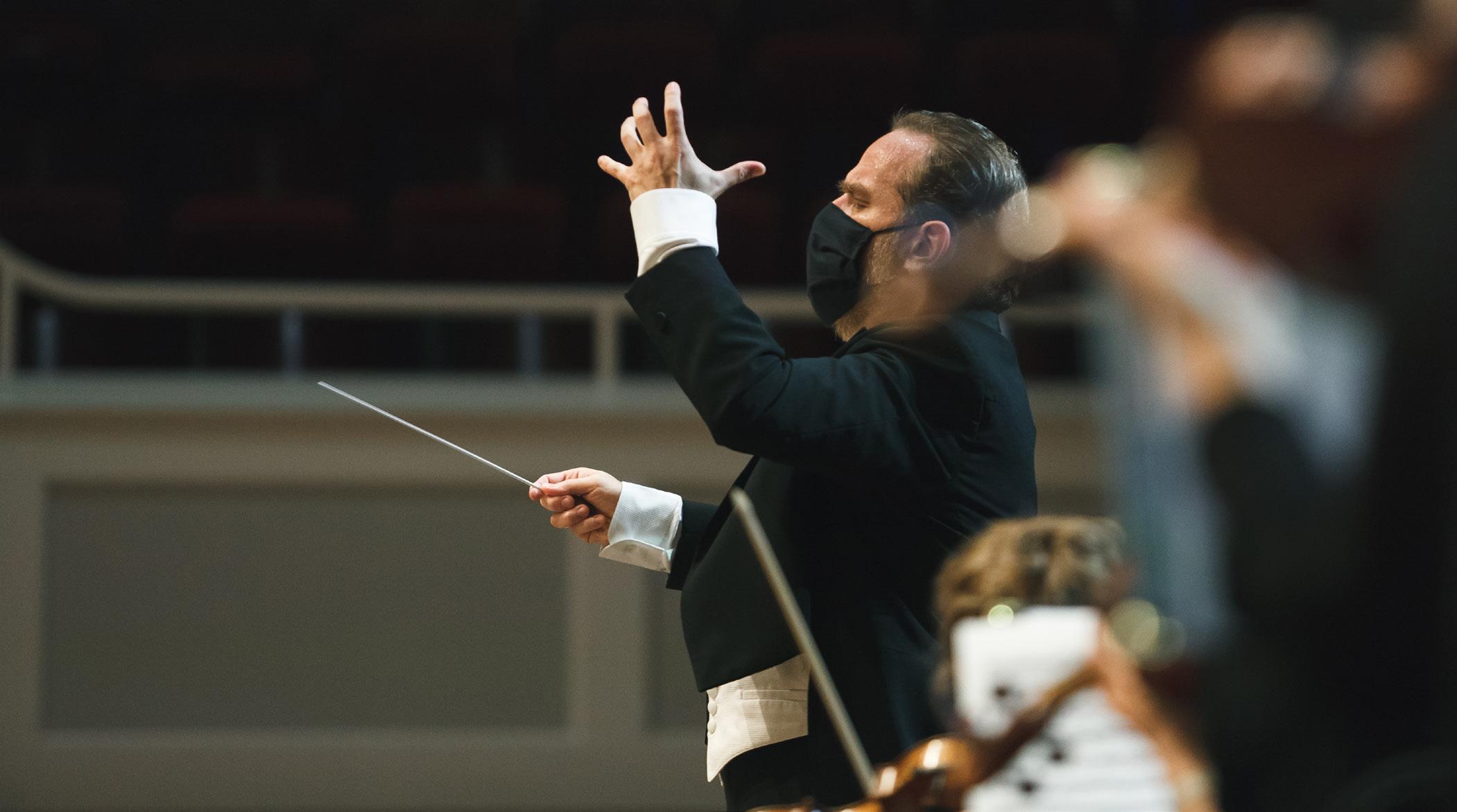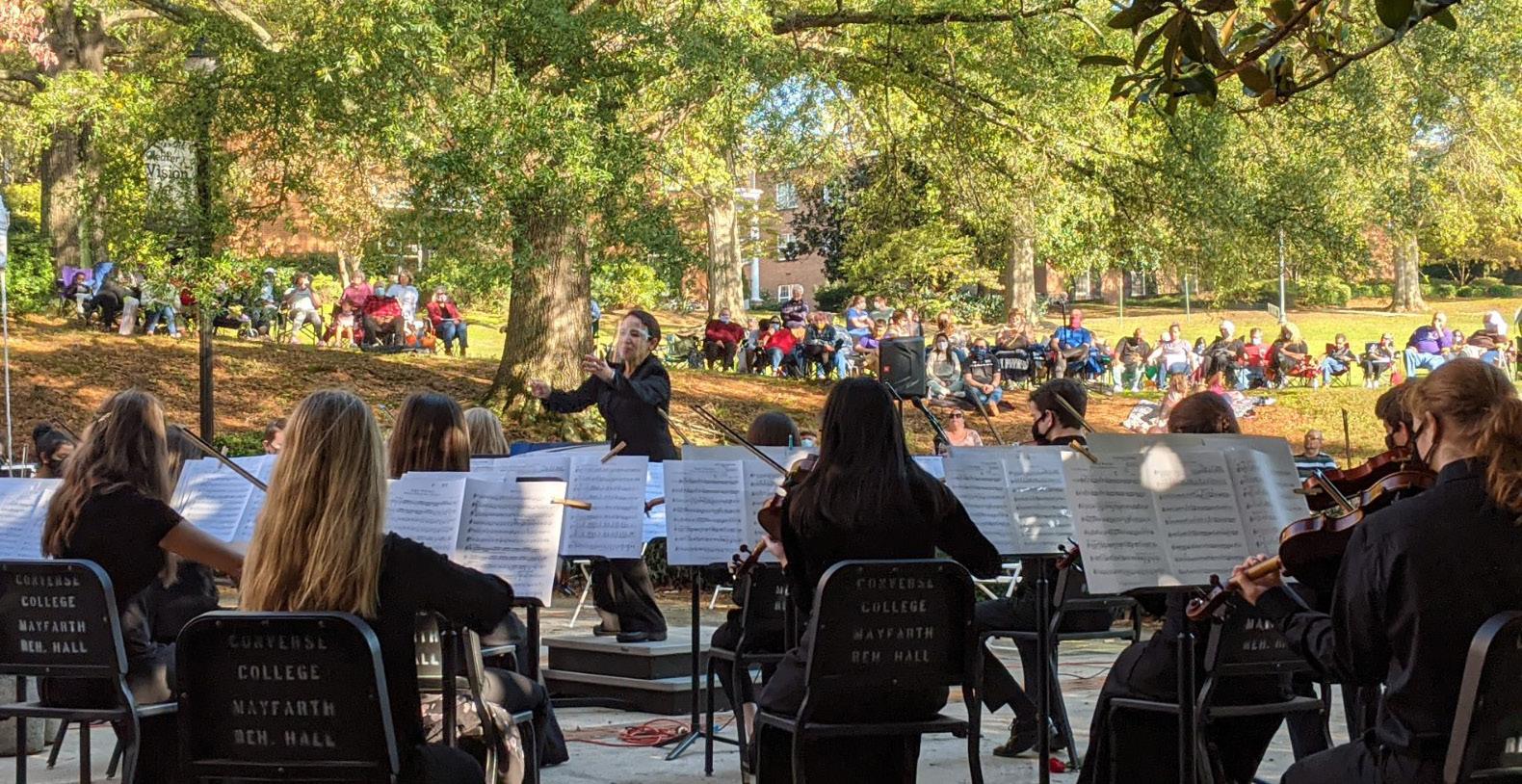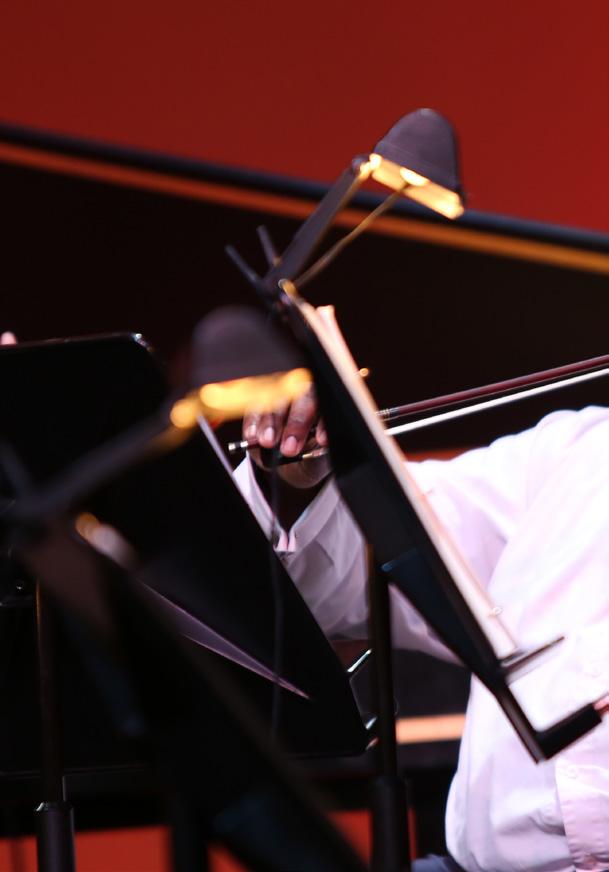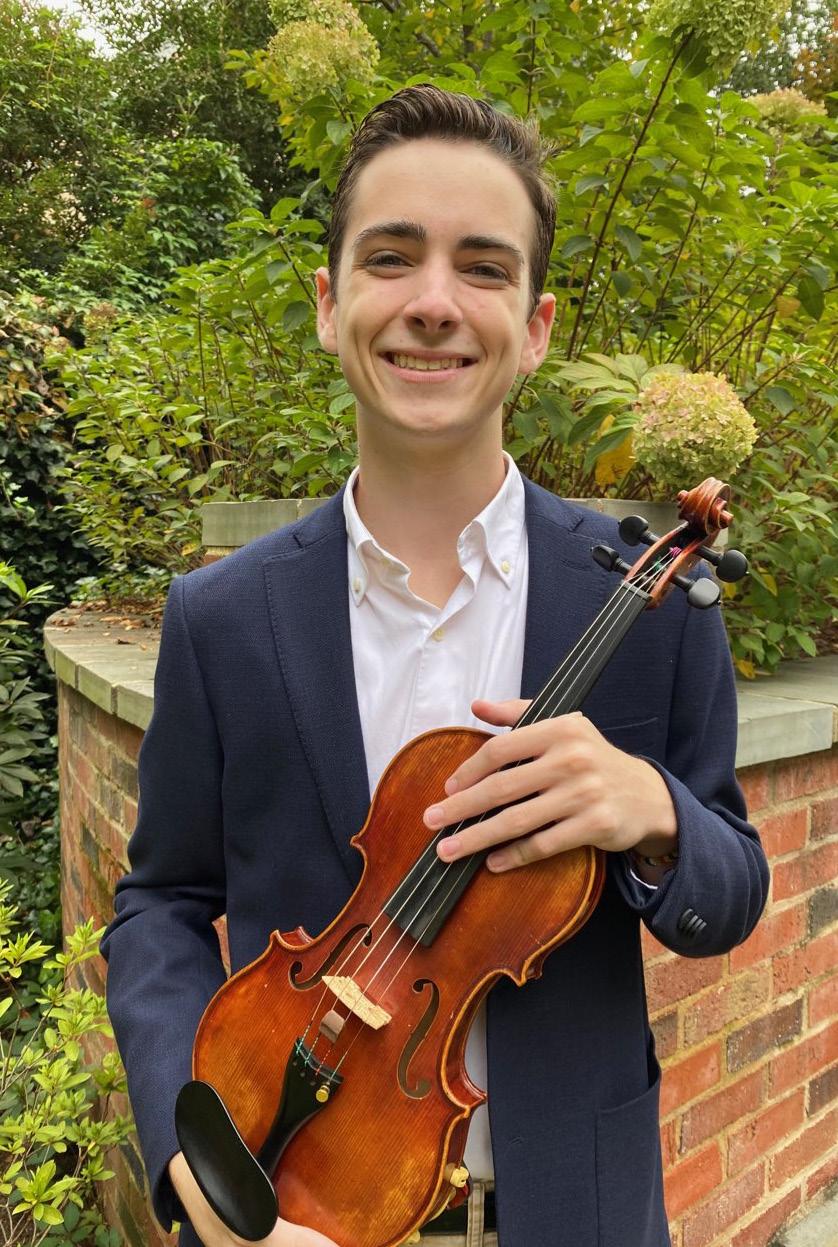
15 minute read
Zimmerli Series: Soulful Serenade
SATURDAY
February 20
Advertisement
Online Premiere @ 7:00 pm | my.sphil.org/watch 2021
Starburst . . . . . . . . . . . . . . . . . . . . . . . . . . . . . Jessie Montgomery 4 min
String Quartet in G Major . . . . . . . . . . . . . . . . . . Florence Beatrice Price II. Andante 7 min
Méditation from Thaïs . . . . . . . . . . . . . . . . . . . . . . . . Jules Massenet featuring Hayden Green, violin 4 min
(see page 54)
Adagietto from Symphony no. 5 in C# minor . . . . . . . . . . . Gustav Mahler 10 min
Serenade for Strings in C Major, Op. 48 . . . . . . . . . . Pytor Ilyich Tchaikovsky 30 min
I. Pezzo in forma di sonatina: Andante non troppo — Allegro moderato II. Valse: Moderato — Tempo di valse III. Élégie: Larghetto elegiaco IV. Finale (Tema russo): Andante — Allegro con spirito

Starburst Jessie Montgomery
(1981-)
Jessie Montgomery is an acclaimed composer, violinist, and educator. She is the recipient of the Leonard Bernstein Award from the ASCAP Foundation, and her works are performed frequently around the world by leading musicians and ensembles. Her music interweaves classical music with elements of vernacular music, improvisation, language, and social justice, placing her squarely as one of the most relevant interpreters of 21st-century American sound and experience. Her profoundly felt works have been described as “turbulent, wildly colorful and exploding with life” (The Washington Post).
Jessie was born and raised in Manhattan’s Lower East Side in the 1980s during a time when the neighborhood was at a major turning point in its history. Artists gravitated to the hotbed of artistic experimentation and community development. Her parents – her father a musician, her mother a theater artist and storyteller – were engaged in the activities of the neighborhood and regularly brought Jessie to rallies, performances, and parties where neighbors, activists, and artists gathered to celebrate and support the movements of the time. It is from this unique experience that Jessie has created a life that merges composing, performance, education, and advocacy. Since 1999, Jessie has been affiliated with The Sphinx Organization, which supports young African-American and Latinx string players. She currently serves as composer-in-residence for the Sphinx Virtuosi, the Organization’s flagship professional touring ensemble. She was a two-time laureate of the annual Sphinx Competition and was awarded a generous MPower grant to assist in the development of her debut album, Strum: Music for Strings (Azica Records). She has received additional grants and awards from the ASCAP Foundation, Chamber Music America, American Composers Orchestra, the Joyce Foundation, and the Sorel Organization.
Jessie Montgomery has provided the following on Starburst:
This brief one-movement work for string orchestra is a play on imagery of rapidly changing musical colors. Exploding gestures are juxtaposed with gentle fleeting melodies in an attempt to create a multidimensional soundscape. A common definition of a starburst: “the rapid formation of large numbers of new stars in a galaxy at a rate high enough to alter the structure of the galaxy significantly” lends itself almost literally to the nature of the performing ensemble who premiered the work, the Sphinx Virtuosi, and I wrote the piece with their dynamic in mind.
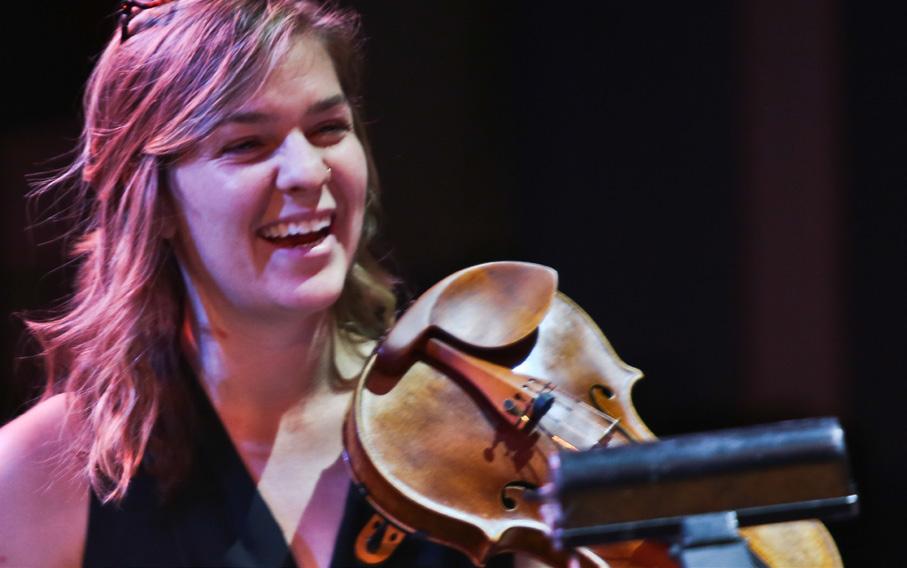
Get to Know Our Principals
Learn a little something about our principal players who are featured on our March 20 concert Glorious Fanfare (see page 38).
Callie Brennan
Concertmaster
Q. What is your favorite place you’ve ever performed and why?
Q. What is your ultimate comfort food?
A. I performed in the Sydney Opera House when I was in college, which was pretty incredible. To be able to perform there, and with my father in the audience, was immeasurably exciting.
It is, as I write this, one of the last grey and scrawny days of 2020, a year that surely ranks among our greyest and scrawniest. In times like these we need all the good news we can get, so here’s a piece of good, even great news for us all: the world is full of great music we don’t know yet. Just as the stars visible to the naked eye – lovely though they may be – are only a tiny fraction of those in the heavens, the music we know is only a fraction of the music already written. Music can slide into obscurity for any number of reasons, and most of those reasons don’t reflect in the least the quality of the music itself; lots of terrific music is awaiting rediscovery.
Just for example: in 2009 a couple in the small Chicago exurb of St. Anne, Illinois, bought and began renovating a longabandoned house. In one of the house’s few intact, dry rooms, they discovered boxes and boxes of music manuscripts, many of which bore the name “Florence Price.” Curious, they took to the internet, and discovered that Florence Price had, in the 1930’s and ‘40’s, been a composer of some repute – she had even been, very briefly, famous, the first Black woman to have a work performed by a major American orchestra. The small house had once been her summer home, and it had hidden for over half a century most of the musical output of someone who might have become one of the most celebrated American composers.
Florence Price had grown up in the relatively cosmopolitan Little Rock, Arkansas, of the turn of the 20th Century, where Jim Crow laws had not prevented the growth of a well-educated Black elite. She had attended the New England Conservatory, one of the few major music schools open to Black students, and after years spent teaching in her hometown and at Clark University in Atlanta, found herself in Chicago by the end of the 1920’s.
In 1932 she submitted two works to the Wannamaker Foundation’s competition; both won awards, with her First Symphony taking the top prize. The Symphony came to the attention of Friedrich Stock, the Chicago Symphony’s German-born Music Director, and he programmed the piece to general acclaim later that year. A star, it would have appeared, was born.
But the “two handicaps -- those of my sex and race,” as she put it in a letter to Serge Koussevitzky, proved enough to prevent her entering the mainstream in a time when racism and sexism were overt in the music world. Stock might have championed her, but as a German he was drummed out of Chicago as geopolitical tensions mounted. Later works were performed by the Women’s Symphonies of Chicago and Detroit, and she was a leader in the tightly-knit community of Black classical musicians in Chicago, but when she died in 1954 only Black newspapers saw fit to print an obituary. Her reputation, like the moldering boxes of music in the St. Anne house, had been abandoned.
But thanks to the efforts of a few intrepid performers and musicologists like the pianist Karen Walwyn, she had not been entirely forgotten when those boxes of music were discovered. And so a Florence Price revival has been gaining steam in recent years, with works
continued on page 34
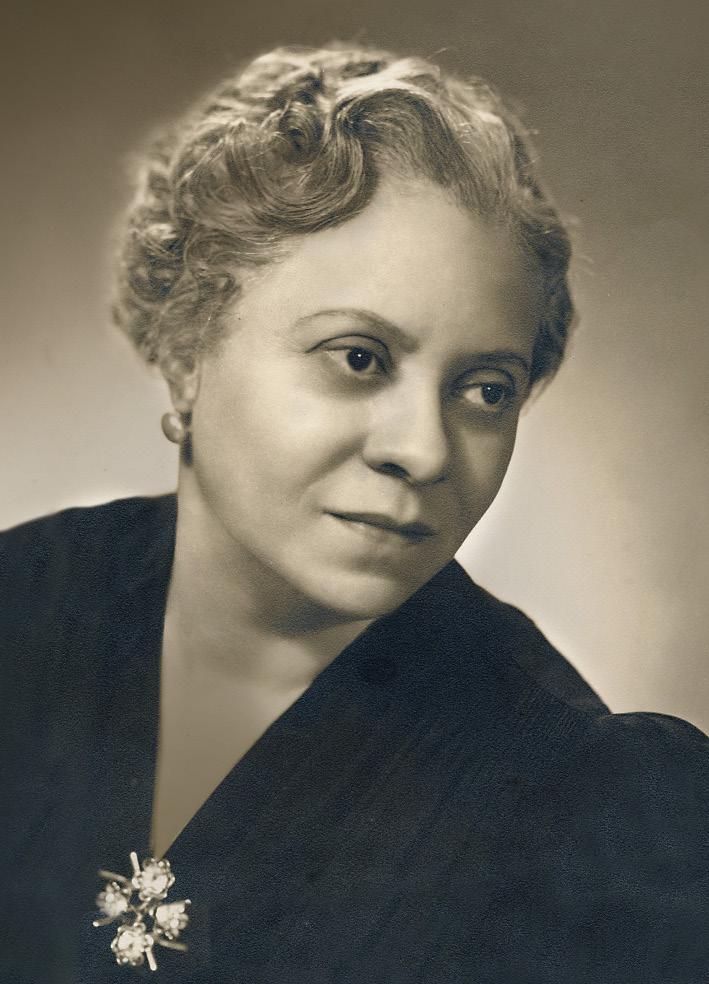
String Quartet Florence Beatrice Price
(1887-1953)
Q. If you could live anywhere in the world where would it be?
A. Manly, in Sydney, Australia
Q. What’s something you’re currently obsessed with?
A. The health and well-being of my basil plants. It’s really touch and go these days with those little sprouts.
Q. If you could choose to be one age forever what would it be?
A. I feel like 9 was pretty great. I don’t really remember, but I’m sure I didn’t have to pay rent back then.
continued from page 33

Méditation from Thaïs Jules Massenet
(1842-1912)

Haelee Joo
Principal Violin II
receiving premieres and acclaim 70 and 80 years after their composition and even a profile in The New Yorker.
The Andante on tonight’s program is an early work, dating to 1929. Formally and harmonically it shows the influence of Dvorak and other late Romantic composers, but its melodies bear the distinct pentatonic stamp of the AfricanAmerican spiritual tradition. It is entirely beautiful, and it offers a powerful hint of the musical treasures still wrongfully neglected in the broken-down corridors of history, and therefore still to come to light.
By the end of his long career, Jules Massenet was known somewhat pejoratively among trendy Parisian musical intelligentsia as “la fille de Gounod” – Gounod’s daughter – and this characterization, while undoubtedly unfair, isn’t entirely unreasonable either. Massenet had been Gounod’s student at the Paris Conservatory, and, like his teacher, won the prestigious Rome Prize at 21. Both men were primarily composers of grand opera, and both were popular and prosperous for many years. Both also shared a finely-honed sensibility that struck audiences of the day as, somehow, characteristically feminine, and indeed both were especially popular among female audiences throughout their careers.
Massenet wrote no fewer that 33 operas over the course of four and a half decades, and perhaps inevitably certain formulas crept into his work. Musically, Massenet incorporated a bit of Wagner – lengthy recitatives, less formal closure between the operas’ arias and ensemble numbers – into a French operatic style perfected by Gounod. Thematically, Massenet returned time and again to the character of the reformed courtesan, the beautiful prostitute who finds religion, perhaps becomes a nun, and dedicates her life to God. Massenet himself was not particularly religious (“I don’t believe in all that creeping-Jesus stuff,” he wrote to the composer Vincent D’Indy, “but the public likes it, and we must agree with the public.”), but he wasn’t foolish enough to throw away the recipe for the popular success he so enjoyed.
Thaïs was written in 1874, and is perhaps the finest of Massenet’s reformedcourtesan operas. Set in fourth-century Alexandria, it tells the story of Thaïs, the kingdom’s haughtiest, proudest courtesan, and Athanael, an ardent young monk. Athanael sets out to convert the worldly title character, and eventually does, but along the way develops carnal feelings for the beautiful Thaïs with predictably tragic results: this being an opera, everyone dies in the end.
The Meditation is taken from the opera’s second act, and immediately precedes the first appearance of the converted Thaïs in the rough habit of a repentant pilgrim. One of the most dramatic violin solos in all operatic literature, its soaring melodies and pulsating emotion have made it a favorite of violinists and a hugely popular standalone piece ever since. It is, in a word, gorgeous, and perfectly captures what Debussy called its composer’s “power of pleasing, which, strictly speaking, is a gift.”
Q. What is your absolutely favorite piece to play?
Q. What is something you are oddly competitive about?
A. My favorite piece to perform is Introduction and Rondo Capriccioso by Saint-Saëns. I love French romantic music. It gives me nostalgia of my life in Paris.
“On what dark subsoil our life is built!” Gustav Mahler once exclaimed in a letter. “Where do we come from? Where does the way out lead? Why do I believe myself free, and yet am wedged into my character as into a prison? What is the purpose of suffering? How can I understand cruelty and malice in the creation of a kindly God? Will the meaning of life finally be revealed in death?”
To those questions Mahler sought answers psychological and spiritual. He consulted for treatment no less a personage than Sigmund Freud: unsurprisingly, Freud told him that the root of his angst lay in his early childhood. And he sought the answers in religion, drifting from the secular Judaism in which he was raised to an unorthodox Christianity before finally converting officially to Catholicism in 1897.
And he sought to work out the answers himself in music. Mahler’s musical aspirations were as lofty as any: his nine monumental completed symphonies were among the grand total of just 16 pieces he finished, and every one of them is shot through with the composer’s quest for spiritual and metaphysical truth.
“My music is lived!” he exclaimed in another letter. “What attitude should those people take who do not ‘live,’ who feel no breath of the rushing gale of our great epoch?” Indeed Mahler was insistent that every note he set down was both an expression of his spiritual quest and a distillation of his life’s experiences. His training, in Vienna and Prague, was in conducting as much as composing, and it was as a conductor that he was best known during his life. A rapid rise through the opera houses of the German-speaking world culminated in his assumption, in 1897, of the directorship of the Vienna State Opera – doubtless the opera world’s most prestigious position at the time – and one year later took command (such as it was) of the fractious Vienna Philharmonic. In 1907, disenchanted with the continual squabbles and the overt anti-Semitism he was subject to in Vienna, he moved to New York, where he directed the New York Philharmonic and the Metropolitan opera. A heart attack, brought on by a bacterial infection, took his life in 1911.
Mahler’s conducting was famed for his obsessive attention to detail, and his compositions share the same quality. He composed painstakingly during summer vacations form conducting in his small cabin in the Austrian Alps. His symphonies demand huge orchestras and in several cases require them to share the stage with choir and vocal soloists, but he orchestrated with the delicacy and intimacy of a chamber musician. The five-movement Fifth was written over the summers of 1901 and 1902; it begins with a funeral march and ends in a triumphant blaze of glory. This fourth-movement Adagietto – which the composer authorized for use as a standalone piece, and which, conducted by Leonard Bernstein, formed the centerpiece of Robert Kennedy’s 1968 funeral – exhibits all the considerable finesse of which its composer was capable. Scored for strings and a crucial harp, the Adagietto is nothing less than celestial in its ineffable tenderness, a sublime musical foretaste, perhaps, of heaven.
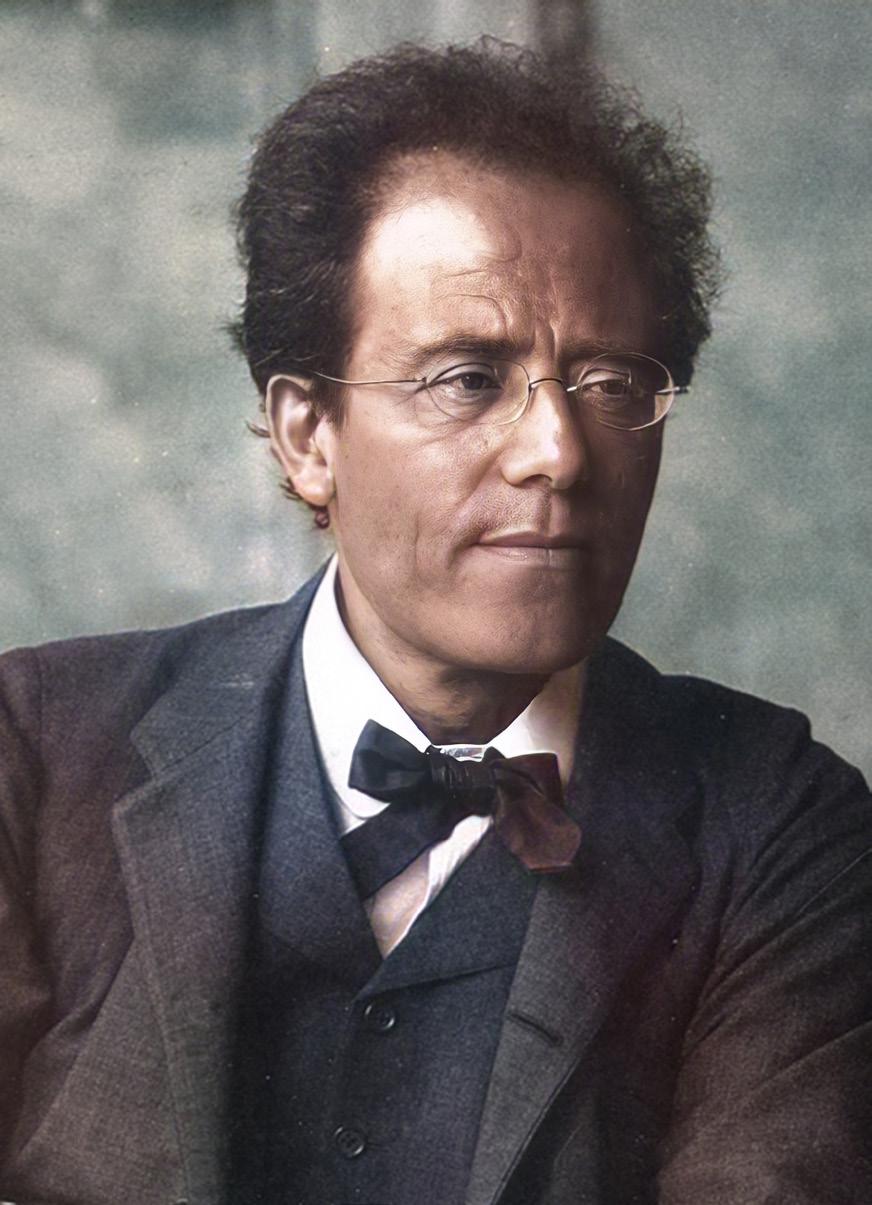
Adagietto from Symphony no. 5 Gustav Mahler
(1860-1911)
Q. What is your greatest accomplishment of which you are the most proud?
A. I try hard to learn foreign languages, and now I am able to speak four different languages!
Q. What is the most spontaneous thing you’ve ever done?
A. When I was living in Europe, I did not get off the train where I needed to. Instead, I stopped where I had never been. I walked around and spent an entire afternoon discovering a new place.

Serenade for Strings Pyotr Ilyich Tchaikovsky
(1840-1893)
While musicologists have performed innumerable valuable services to the world, they’ve been known to get up to some mischief on occasion, as well. Readers need look no further than the “Tchaikovsky” entry in the fifth edition of the New Grove Dictionary of Music and Musicians for proof.
New Grove is the most respected multi-volume reference work on musical subjects; every 25 years or so a brand-new, entirely updated edition is published. The fifth of these, which appeared in 1979, prints as fact a story about Tchaikovsky’s death, that – were it true – would be surely the most sensational demise of any composer.
Earlier in the decade a Russian émigré musicologist published a paper that, citing an overheard deathbed confession that in turn cited a second, decadesold deathbed confession, claimed that Tchaikovsky had not died of cholera as had previously been believed but had poisoned himself with arsenic. The story went that the composer had been caught in flagrante with a young nephew of the Romanoff family; before the liaison was made public, a secret “honor court” made up of Tchaikovsky’s former military school classmates gave the composer two options: a dignified suicide, or public scandal and exile to Siberia. Tchaikovsky, we are to believe, chose the former, and his physician, who was in on the conspiracy (as was his family), supplied him with the poison. That so wild a tale could be published as fact in the New Grove, despite the conspicuous lack of any shred of evidence other than a third-hand deathbed confession, tells us something about the preoccupations of the 1970’s, but even in its outlandishness it’s a testament to the composer’s tumultuous inner life. Tchaikovsky was indeed gay, as his frank letters to his brother Modest make clear. In fact he spent much of his adult life struggling with that aspect of his being, public acknowledgment of which would have crippled his career and maybe even jeopardized his life in Czarist Russia. He even went so far as to marry one his students, but their marriage remained unconsummated: on their wedding night the composer fled his young bride and, distraught, walked into the Moskva River. And his eventual death was, in a certain sense, self-inflicted – he drank a glass of unboiled water during a raging cholera epidemic and contracted the disease that killed him.
Tchaikovsky was one of the most personal and emotionally direct of composers, and so his difficult inner life is indeed pretty directly relevant to his music. It is especially relevant to the Serenade, as the composer himself wrote in a letter: “The 1812 Overture [which was written at the same time as the Serenade] will be very showy and noisy, but will have no artistic merit because I wrote it without love. But the Serenade, on the contrary, I wrote from inner compulsion. This is a piece from the heart, and so I venture to say it does not lack artistic worth.”
The Serenade was born after an extended trip to Italy prescribed by the composer’s doctor to heal the trauma caused by his failed attempt at marriage. And its four movements so seem to reflect both the warmth and sunshine of the Italian countryside and the emotional journey from exhaustion to elation familiar to anyone who has recovered from a serious illness. And in fact its finale is based on two Russian folksongs, as the Russian composer’s emotional homecoming reflects a gloriously literal homecoming as well.
Chris Vaneman
Contributing Author




